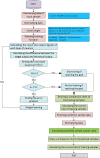Clinicopathological features of fibrosarcomatous dermatofibrosarcoma protuberans and the construction of a back-propagation neural network recognition model
- PMID: 33499900
- PMCID: PMC7836157
- DOI: 10.1186/s13023-021-01698-4
Clinicopathological features of fibrosarcomatous dermatofibrosarcoma protuberans and the construction of a back-propagation neural network recognition model
Abstract
Background: Fibrosarcomatous dermatofibrosarcoma protuberans (FS-DFSP) is a form of tumor progression of dermatofibrosarcoma protuberans (DFSP) with an increased risk of metastasis and recurrence. Few studies have compared the clinicopathological features of FS-DFSP and conventional DFSP (C-DFSP).
Objectives: To better understand the epidemiological and clinicopathological characteristics of FS-DFSP.
Methods: We conducted a cohort study of 221 patients diagnosed with DFSP and built a recognition model with a back-propagation (BP) neural network for FS-DFSP.
Results: Twenty-six patients with FS-DFSP and 195 patients with C-DFSP were included. There were no differences between FS-DFSP and C-DFSP regarding age at presentation, age at diagnosis, sex, size at diagnosis, size at presentation, and tumor growth. The negative ratio of CD34 in FS-DFSP (11.5%) was significantly lower than that in C-DFSP (5.1%) (P = 0.005). The average Ki-67 index of FS-DFSP (18.1%) cases was significantly higher than that of C-DFSP (8.1%) cases (P < 0.001). The classification accuracy of the BP neural network model training samples was 100%. The correct rates of classification and misdiagnosis were 84.1% and 15.9%.
Conclusions: The clinical manifestations of FS-DFSP and C-DFSP are similar but have large differences in immunohistochemistry. The classification accuracy and feasibility of the BP neural network model are high in FS-DFSP.
Keywords: BP neural network; Clinicopathological features; Dermatofibrosarcoma protuberans; Fibrosarcomatous.
Conflict of interest statement
The authors declare that they have no competing interests, either financial or non-financial, that could be perceived as prejudicing the impartiality of the research reported.
Figures




Similar articles
-
A systematic review of outcome data for dermatofibrosarcoma protuberans with and without fibrosarcomatous change.J Am Acad Dermatol. 2014 Oct;71(4):781-6. doi: 10.1016/j.jaad.2014.03.018. Epub 2014 Apr 19. J Am Acad Dermatol. 2014. PMID: 24755121
-
Fibrosarcomatous ("high-grade") dermatofibrosarcoma protuberans: clinicopathologic and immunohistochemical study of a series of 41 cases with emphasis on prognostic significance.Am J Surg Pathol. 1998 May;22(5):576-87. doi: 10.1097/00000478-199805000-00009. Am J Surg Pathol. 1998. PMID: 9591728
-
Dermatofibrosarcoma protuberans: a clinicopathological, immunohistochemical, genetic (COL1A1-PDGFB), and therapeutic study of low-grade versus high-grade (fibrosarcomatous) tumors.J Am Acad Dermatol. 2011 Sep;65(3):564-575. doi: 10.1016/j.jaad.2010.06.020. Epub 2011 May 12. J Am Acad Dermatol. 2011. PMID: 21570152
-
[Fibrosarcomatous dermatofibrosarcoma protuberans: a clinicopathological analysis of 12 cases].Zhonghua Bing Li Xue Za Zhi. 2013 Nov;42(11):753-7. Zhonghua Bing Li Xue Za Zhi. 2013. PMID: 24447553 Chinese.
-
Preoperative Risk Factors for Fibrosarcomatous Transformation in Dermatofibrosarcoma Protuberans.Anticancer Res. 2022 Jan;42(1):105-108. doi: 10.21873/anticanres.15463. Anticancer Res. 2022. PMID: 34969715 Review.
Cited by
-
The clinical application of lateral chest flap transfer combined with relay skin flap transfer to repair soft tissue defects of the chest wall after tumor resection.J Thorac Dis. 2022 Sep;14(9):3500-3507. doi: 10.21037/jtd-22-1067. J Thorac Dis. 2022. PMID: 36245592 Free PMC article.
-
Research on improved convolutional wavelet neural network.Sci Rep. 2021 Sep 9;11(1):17941. doi: 10.1038/s41598-021-97195-6. Sci Rep. 2021. PMID: 34504162 Free PMC article.
-
Clinical and histopathological characteristics of atrophic pigmented dermatofibrosarcoma protuberans: A retrospective study of 14 cases.Heliyon. 2024 Oct 11;10(22):e39271. doi: 10.1016/j.heliyon.2024.e39271. eCollection 2024 Nov 30. Heliyon. 2024. PMID: 39634408 Free PMC article.
-
Malignant Superficial Mesenchymal Tumors in Children.Cancers (Basel). 2022 Apr 26;14(9):2160. doi: 10.3390/cancers14092160. Cancers (Basel). 2022. PMID: 35565289 Free PMC article. Review.
References
-
- Bowne WB, Antonescu CR, Leung DH, Katz SC, Hawkins WG, Woodruff JM, Brennan MF, Lewis JJ. Dermatofibrosarcoma protuberans: a clinicopathologic analysis of patients treated and followed at a single institution. Cancer. 2000;88(12):2711–2720. doi: 10.1002/1097-0142(20000615)88:12<2711::AID-CNCR9>3.0.CO;2-M. - DOI - PubMed
Publication types
MeSH terms
LinkOut - more resources
Full Text Sources
Other Literature Sources
Medical

